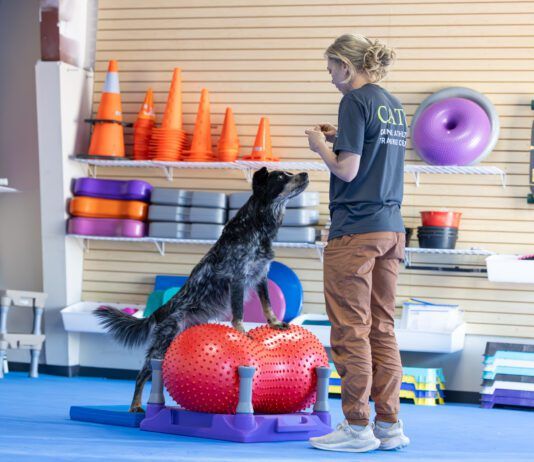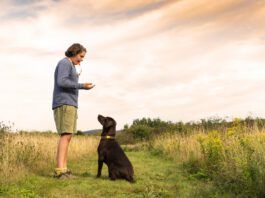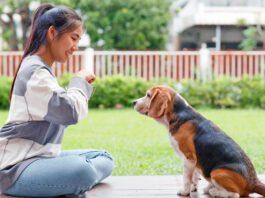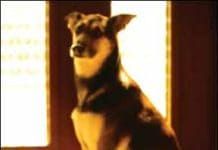Training a Dog to Behave When Guests Visit
As much as we worry if we’re doing the best for our dogs, any veterinarian can tell you that many of the problems they see are accidents, predictable and completely preventable., Around any holiday, that’s even more true, when people get busy, routines get changed and visitors come to call. All the changes put both people and dogs at higher risk of accident or illness.
How to Teach Loose Leash Walking to Your Dog
with the treats delivered right at her side
Beware of the Poisoned Dog Cue
A cue becomes “poisoned” when the dog’s association with the cue is ambiguous – it’s sometimes associated with positive reinforcement, and sometimes associated with punishment. When the association is ambiguous, the dog becomes confused and doesn’t know what to expect. Poisoning your “Come!” cue is the best way to ensure that she’ll stop and weigh her choices, then take off after the bounding deer, rather than come galloping to you when you call.
Training Your Dog to Execute an “Extremely Fast” Reliable Recall
having students compete for the fastest recall in heat after heat
A Strong Recall is Critical During Your Dog’s Water Play
No matter how strong your dog’s recall may be (and we recommend it be quite strong if you’re considering letting your dog off-leash at the beach, lake, or river), it’s important to remember that the excitement of being in the water, coupled with the potential desire to swim out for a toy or chase a flock of ducks, could result in his recall falling on deaf ears. Prior to fun water play, consider brushing up on your dog’s recall with the following...
Dog Training Questions Answered by the Experts!
I love the Whole Dog Journal and have implemented many of your positive dog training techniques and suggestions with our dog, Izzy. I hope that you may be able to further help us with her issue. Izzy is a wonderful 31/2-year-old Australian Shepherd/Border Collie-mix. She’s super smart and well-trained, with lots of energy and a constant need for learning and exercise. In the last couple years, however, her canine aggression has gotten to be a problem (I’m guessing it’s a protective instinct). She barks (like a yell) and confronts people in a number of situations.
Counter-Conditioning and Desensitization (CC&D)
Counter conditioning and desensitization (CC&D) involves changing your pup's association with a scary stimulus from negative to positive. The easiest way to give most pups a positive association is with very high-value, really yummy treats. I like to use chicken canned, baked or boiled.
Teaching Your Dog Calm, Slow Breathing
Radio talk show psychologist Dr. Joy Browne offers her listeners a stress-reducing “Square Breathing” technique. To relax before or during any potentially anxiety-producing experience, try square breathing: Inhale to the count of four, hold to the count of four, exhale to the count of four, and hold for four. With practice, you can increase each side of the “square” to a count of eight or even 20; the longer the count, the slower and more calming the breathing.
Counter-Conditioning and Desensitization for Reducing Dog Reactvity
Counter-conditioning involves changing your dog’s association with a scary or arousing stimulus from negative to positive. Desensitization is starting with a very low-level intensity of aversive stimulus until the dog habituates to (or changes his association with) the aversive, and then gradually increasing the strength until the dog is comfortable with the stimulus at full intensity. The easiest way to give most dogs a positive association and to help them become comfortable with a stimulus is with very high-value, really yummy treats. I like to use chicken – canned, baked, or boiled; most dogs love chicken. Here’s how the CC&D process works.
Touch/Restraint Desensitization Protocol
Touch dog’s shoulder with one hand, feed treat with other hand, remove both hands. Repeat multiple times until touch to the shoulder elicits an automatic look for the other hand to arrive with treat. Move touch process to various other parts of dog’s head and body until a touch anywhere on the dog elicits an auto-look for the delivery of a treat. Pay extra attention to any body part where your touch seems to elicit a more intense response from the dog.
The Four Principles of Operant Conditioning for Dogs
The dog's behavior makes something good happen. Positive
Debunking the “Alpha Dog” Theory
so he's trying it again.üIs this dog dominant or acting like an "alpha dog"? No; he's been trained to jump up and bite on cue."















